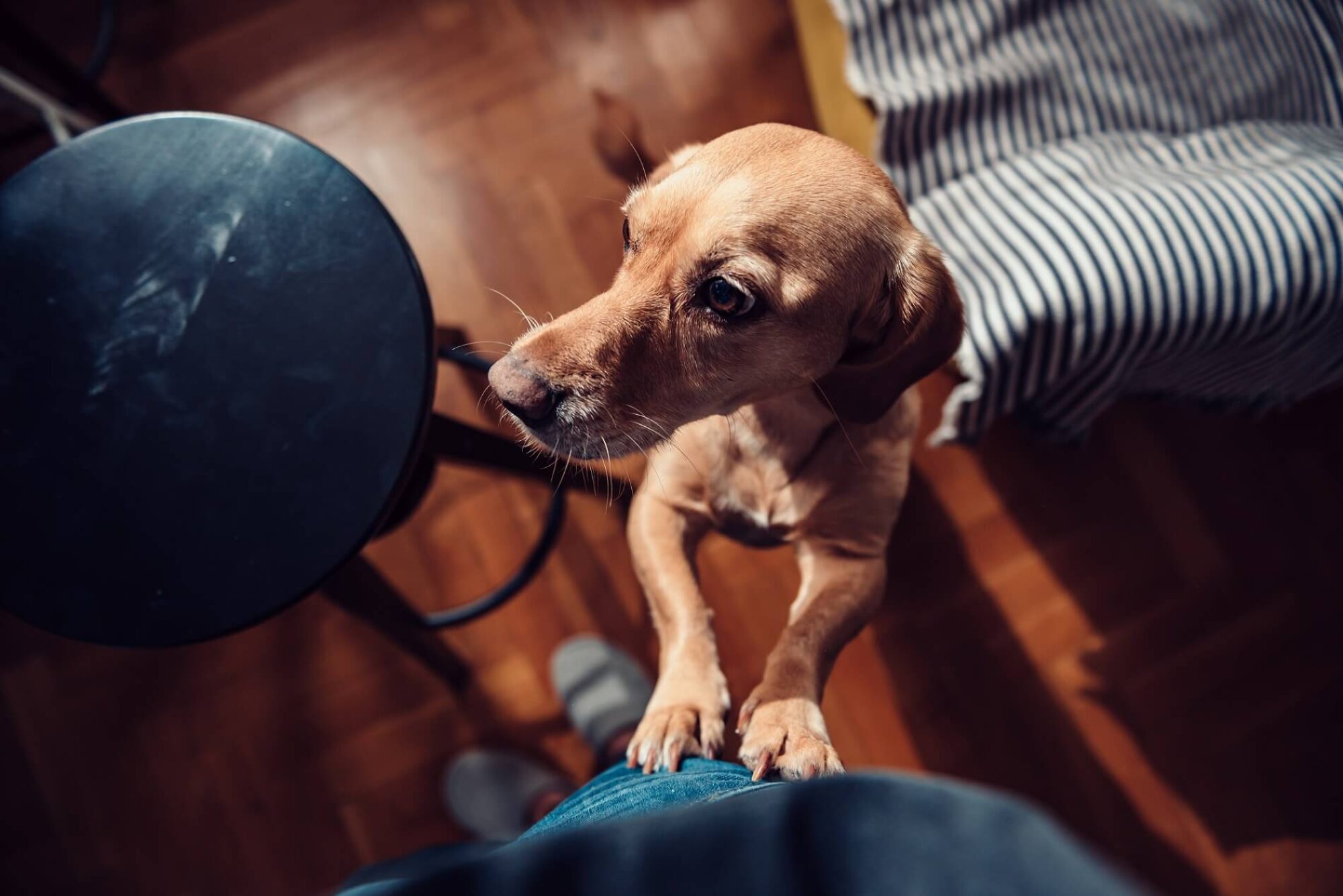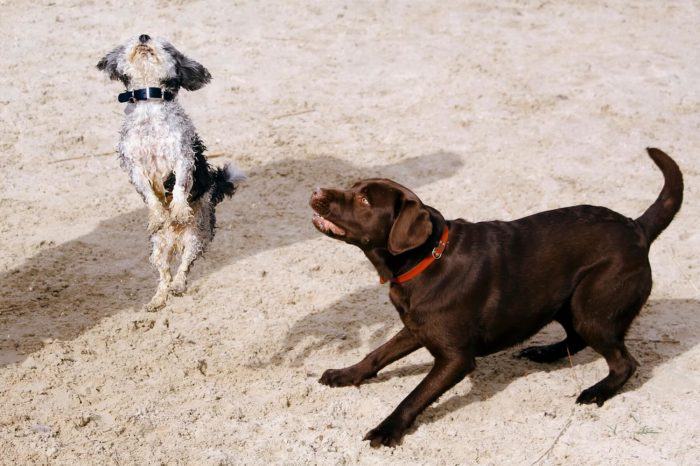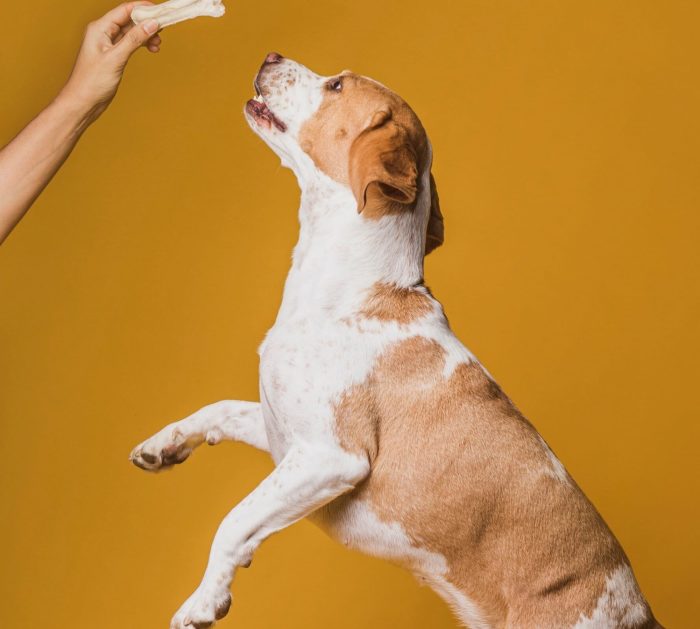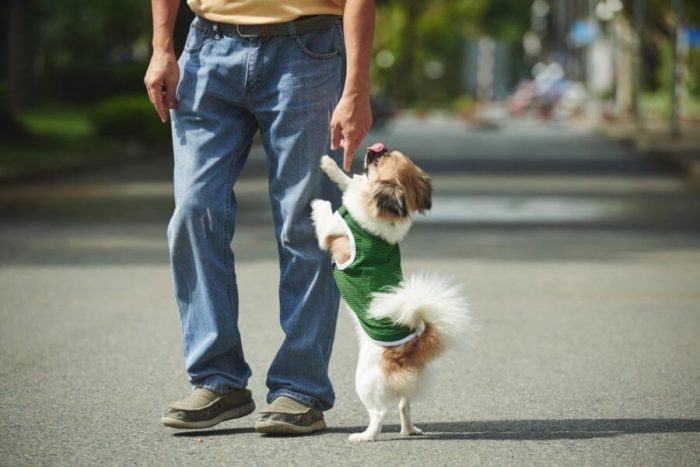How to train a dog not to jump on you or others?
Jumping up is one of the most common problems humans encounter with their dogs (Lindsay, 2011). There are numerous articles and varying advice on this subject and yes, this is another one! However, this article maybe a little different in its approach. So how to train a dog not to jump on you or others?
Teaching a dog how not to jump on others is what most dog owners wish to achieve
How to teach your dog not to jump at you and others is something that most dog owners wish to train, especially with young dogs. It is important to resolve jumping up issues to help prevent physical injury to our dog and others. Canines are not naturally designed to spend prolonged periods on their back legs and with many breeds predisposed to developing joint issues, it is vital that they learn there is no need to go up on their back legs. Dogs jumping (regardless of their size) can pose a significant risk of injury to anyone – especially young children and elderly adults, by knocking them down, bumping them and or scratching.
Why do dogs jump up?
The main explanations given as to why dogs jump are:
Your dog is greeting a visitor – Donaldson (1996) explains it is believed the origin of jumping up lies in the greeting rituals of puppies towards adult dogs, in the form of jumping and licking at the adult dogs mouth to trigger regurgitation of food for the pup to eat. This hypothesis is supported by the observable behaviour of puppies jumping up at humans when they meet them.
The dog is trying to elicit attention – Humans are vertical (as we stand upright on two legs) and dogs are horizontal (on four legs) so if the dog wants to know we are engaged with them by obtaining our gaze they learn jumping up is an effective way of getting attention. It is difficult to ignore a dog who is jumping at you, especially as they may increase the frequency and intensity of the jumping, if it has worked previously in gaining attention. Therefore, pushing away the dog and telling it off for jumping up will reinforce the behaviour, as it has achieved the goal of getting attention.
The dog is communicating frustration – this often would be grouped in with eliciting attention, however for me there are important differences in the observable behaviours. I believe when a dog is jumping to communicate its frustration with a situation the jumping is more of a shove towards the human and this pushing with their front paws, increases in force. This is important to note, as by becoming aware of this we could intervene appropriately and avoid any escalation in behaviour which potentially could have resulted in aggression.
The behavior of the dog when jumping on others
As sadly our dogs do not talk as we humans do, we can only ever hypothesise as to what the function of the jumping up behaviour is. Observation of behaviour and measuring physiological states may give clues about what our dogs are feeling, however emotions are an internal state and therefore personal to the experience of the individual. Physiological changes are not clearly visible, so to change behaviour the physical events that reliably produce it, must be identified. We should spend time trying to figure out what the function of the behaviour is for the individual in front of us. This will enable management to help prevent the dog from continuing to receive reinforcement for the unwanted behaviour and enable the observer to encourage more suitable alternative behaviours.
How to train a dog – Finding a solution
Thorndike proposed the “Law of effect” which states that any behaviour that is followed by pleasant consequences is likely to be repeated, and any behaviour followed by unpleasant consequences is likely to be stopped. This principle helps us to understand how positive reinforcement and positive punishment operate. However, to establish and maintain the welfare of our dogs we should avoid using positive punishment. Which also damages the human-dog relationship and will cause serious un-desirable fallout.
Thorndike (1898) explained “Behaviour is a function of its consequences”. Rather than focus on stopping the dog from jumping, I prefer to tackle the issue from the viewpoint of what can teach the dog to do instead. To be able to do this it, it is advisable to carry out a functional assessment within which you should:
- Define a clear description of the observable jumping up behaviour.
- Ascertain the factors which predict when the jumping up will and will not occur i.e. where, when and with whom?
- Identify the consequences that maintain the jumping up- what is the function? This is important as behaviour is flexible in order to gain outcome, so it enables us to find alternative behaviours to train.
- Find appropriate alternative behaviours that could produce the same consequences that appear to maintain the jumping up.
Behaviour change using principles of applied behaviour analysis can be performed with non-punishment procedures, using differential reinforcement. Differential reinforcement is defined as reinforcing an appropriate replacement behaviour, an incompatible behaviour, or absence of the challenging behaviour, whilst withholding reinforcement for the undesirable behaviour.
There are four forms of differential reinforcement:
- Differential Reinforcement of Alternative behaviour (DRA) – this process involves reinforcing a behaviour that serves as an alternative to the inappropriate behaviour.
- Differential Reinforcement of Incompatible behaviour (DRI) – reinforcement of a behaviour that is both desirable and topographically incompatible with the undesirable behaviour.
- Differential Reinforcement of Other Behaviour (DRO) – When using Differential Reinforcement of Other Behaviour, you reinforce any behaviour offered except the unwanted behaviour.
- Differential Reinforcement of Low Rates (DRL) – DRL involves teaching the learner to reduce the frequency of a behaviour, when the behaviour itself is not inappropriate, but the frequency in which it is engaged in it is undesirable.
How to resolve your dog jumping up at you and others
The goal of the behaviour modification plan is to teach the dog to achieve the same purpose of the problem behaviour through an alternative taught behaviour. This involves redesigning the physical and social contexts. When applying differential reinforcement principles to the undesirable behaviour of jumping up at you or another person a behaviour modification plan based upon differential reinforcement of an alternative, incompatible behaviour is a successful option. A suitable and relatively easy solution is to train your dog to have 4 paws on the ground around you and others results in substantial positive reinforcement. Please ensure when practising the dog can choose to opt out of the session by practising in an area that offers it the choice to be able to physically move away.
Technique for teaching your dog not to jump at you:
Stage 1
Have lots to tiny tasty morsels of your dogs favourite food in a pouch or pocket to help set you for up success, by ensuring you do not accidently drop them. Start to approach your dog, the moment it looks at you and as you move off, take a piece of food from the pocket/pouch and gently toss a treat onto the floor next to the front end of your dog. With every step you move towards the dog toss once piece of food next to them. When you are within a metre of your dog, sprinkle a few (5 to 10) pieces of food on the ground by them and walk away. This will enable you to move away from your dog without it following you, ready to start another repetition of approach and feed. Practise until your dog is remaining in place with 4 paws on the ground reliably as you approach and stop at a metres distance.
Stage 2
Once you have achieved stage 1, start to practise on each repetition getting one step closer than a metre from the dog. Repeat until you have approached and tossed a treat to the dog for each step towards them, successfully getting to be in front of the dog with no jumping. Remember each time you get to the one step closer mark, sprinkle 5 to 10 pieces of food on the ground by them and walk away to restart the exercise. When you are able to approach the dog and be directly in front of them you can gradually start to decrease the treat delivery on the approach to every other step, then every third step and so on, until you approach the dog with no feeding and the reinforcement is delivered only when you get to be right in front of them and you place 5 to 10 pieces of food on the floor directly in front of the dog. It is fine to vary the number of morsels being sprinkled.
Stage 3
Once the behaviour of dog remaining on 4 paws as you approach has been established and practised, we can teach duration of you being in front of the dog without it jumping up at you. When your dog looks at you approach, when you get in front of your dog carefully drop one piece of food by your feet in front of them and repeat 10 times. After the 10th piece of food, sprinkle a few pieces and move away ready for the next practise or for you to cease the session. On each repetition start to slow the treat delivery down, by having once second gaps between the 10 treats being dropped. Remain practising this until the dog is clearly relaxed and then start to gradually increase the duration (a second at time) between each treat being dropped by your feet.
Stage 4
Now we can start to replace the precise reinforcement of feeding with physical reinforcement of stroking and verbal praise, once you have approached the dog and it has kept 4 paws on the floor. I leave these until stage 4, as sometimes these interactions can trigger jumping up. Approach the dog when it looks at you, as long at it keeps 4 paws on the ground get directly in front of the dog and when you are there praise the dog and place the treats on the floor then walk away as before. On the next repetition once you have successfully approached the dog, praise it and gently stroke its chest before placing the treats on the ground. Repeat ensuring the dog is calm and relaxed during these interactions. Once the 4 paws on the ground, calm whilst being stroked on the chest has been established you can start to slowly and gradually decrease the number of treats fed on the floor after the praise and stroking.
Train a dog not to jump on you or others – Problem solving
- If the dog approaches you during the session, immediately place a few treats by your feet for it to consume and interrupt it to prevent it from jumping up at you. Move away and set up again, ready to re-start the session.
- If the dog does jump up at you, do not say anything to the dog, do not touch it and avoid eye contact. Immediately use some food in a hand to lure if off of you and the moment the dogs front feet are on the ground, feed it and then place (5 to 10 pieces) of food on the ground by your feet.
- If the dog moves away from you, then cease the session and try again another time.
Technique for teaching your dog not to jump at other people:
Brief the other person who is assisting the training that initially they are not to interact with the dog and you will advise them when, if and how to interact with the dog when appropriate to do so. This is to set everyone up for success.
Place your dog on a suitable harness and lead and keep at a safe distance from the person (over 1 metre). Ask the other person to ignore the dog initially to help prevent any inadvertent reinforcement of jumping. As before have some of your dogs favourite food in small tasty easily accessible in a pocket or pouch.
PLEASE ENSURE that at no point does the dog feel trapped in the training situation and at all times the lead is relaxed.
Stage 1
Have a large handful of the tasty rewards in the hand that is not holding your dogs lead. Ask the helper to start walking towards you and your dog on lead. The moment the person starts to move towards you, place your hand on your dog’s nose and feed it a piece at a time continuously during the approach. When the person gets to a metre from your dog scatter 10 pieces and ask the person to walk away. Repeat until the dog is remaining engaged and relaxed with the persons approach.
Stage 2
Repeat stage 1 asking the person to approach closer a step at a time, before scattering treats and re-starting. Practise until the dog is clearly comfortable with the person approaching and remains with 4 paws on the ground whilst the person comes up next to them. Once you have achieved the person walking up right next to your dog you can start to gradually reduce the food delivery to every second, every 2 seconds etc, the treats are delivered upon the arrival of the person.
Stage 3
Now the person can approach without the dog attempting to jump at them we can start to build the duration of close proximity. Once the person arrives in front of your dog carefully drop one piece of food by the persons feet and repeat 10 times. After the 10th piece of food, sprinkle a few pieces and move away ready for the next practise or for you to cease the session. On each repetition start to slow the treat delivery down, by having once second gaps between the 10 treats being dropped. Remain practising this until the dog is clearly relaxed and then start to gradually increase the duration (a second at time) between each treat being dropped by your feet.
Stage 4
Now we can start to replace the reinforcement of feeding with physical reinforcement of stroking and verbal praise, once the person can approach and remain close by the dog for a duration of over 30 seconds and it has kept 4 paws on the floor. The person approaches the dog and will stand directly in front of the dog. As long as the dog remains with 4 paws on the ground the other person can verbally praise the dog, you will place multiple treats on the floor and the person will walk away. Repeat a few times and when you can see the dog is comfortable with the other person can approach, praise the dog and gently stroke its chest for less than 3 seconds. As before you will then place the treats on the ground and the person will walk away. When reliability has been achieved, ensuring the dog is relaxed and relaxed during these interactions, the duration of interaction with the person can be gradually increased a second at time.
When the dog has learnt the goal behaviours of keeping 4 paws on the ground, remaining calm whilst being stroked, for a duration have been established you can start to slowly and gradually decrease the number of treats fed on the floor after the praise and stroking.
Important things when training your dog
👉 Until you have taught the goal behaviours, keep your dog on a suitable lead and at a safe distance from others to ensure it in not able to practice jumping up at people. 👉 If the dog does jump up at someone, no one should say anything to the dog, do not touch it and avoid eye contact. Immediately use some food in a hand to lure if off and the moment the dogs front feet are on the ground, feed it and then lure it away from the person feeding as you move away. 👉 If the dog moves away from the person, then cease the session and try again another time. ❗ REMEMBER to set your dog up for success by catching the dogs attention before they jump at someone and pay them for directing their attention onto you and keeping their feet on the floor.
Jumping up can be a problematic behaviour and stressful for all involved. However, once you set the environment up for success by preventing opportunities for the behaviour to be practised and have taught you dog that is far more rewarding to keep four paws on the floor, you will have a long term solution.
Before you go! Check our blog, you find there more useful R+ knowledge! *Sure, show me your blog – click here* Do you know we have dog training courses? No?! Take a look! *Wow! I want to check it now! – click here*
References
- Athens, E. & Vollmer, T. (2010). “An investigation of differential reinforcement of alternative behavior without extinction”. Journal of applied behavior analysis, 43(4), 569–589. https://doi.org/10.1901/jaba.2010.43-569
- Bradshaw, J. (2011) In Defence of Dogs, Why dogs need our understanding. London: Penguin Group
- Donaldson, J. (1996) The Culture Clash. Hertfordshire: James & Kenneth UK
- Fox, M. (1978) The Dog, Its Domestication and Behaviour. New York: Garland STPM Press. cited in: Serpell, J. (1995) The Domestic Dog its evolution, behaviour and interactions with people. Cambridge: The Press Syndicate of The University of Cambridge.
- Gray, P. (2011). Psychology (6th ed.) New York: Worth Publishers.
- Lindsay, S. (2000) Handbook of Applied Dog Behaviour and Training. Vol 3. Procedures and Protocols Iowa: Blackwell Publishing Company.
- Lorenz, K. (1954) Man Meets Dog. London: Methuen. cited in: Serpell, J. (1995) The Domestic Dog its evolution, behaviour and interactions with people. Cambridge: The Press Syndicate of The University of Cambridge.
- Part, C. Kiddie, J. Hayes, W. Mills, D. Neville, R. Morton, D. Collins, L. (2014) Physiological, physical and behavioural changes in dogs (Canis familiaris) when kennelled: testing the validity of stress parameters. Physiol Behav.;133:260-271. doi:10.1016/j.physbeh.2014.05.018
- Skinner, B. F. (1938). The behavior of organisms: An experimental analysis. New York: Appleton-Century.
- Thorndike, E. L. (1898). Animal intelligence: An experimental study of the associative processes in animals. Psychological Monographs: General and Applied, 2(4), i-109.
- Scott, J. Fuller, J. (1965) Genetics and the Social Behaviour of the Dog. Chicago: University Chicago Press. cited in
See also other posts:
June 30, 2023
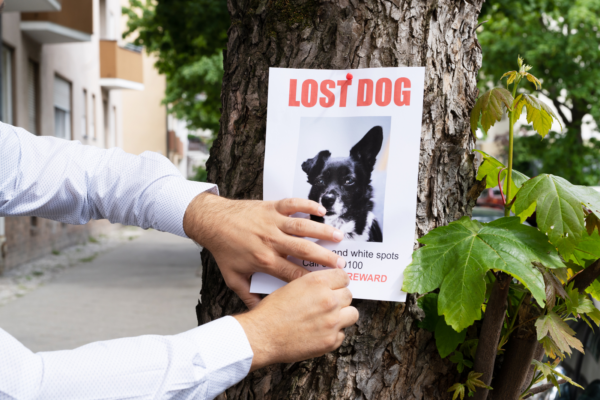
Get Your Lost Dog Back Home Quickly: Follow These 12 Tips for Success
Vacations favor more frequent and longer walks with our furry friends. We travel, visit new places. Summer makes us loosen our brakes and allow our…
June 30, 2023
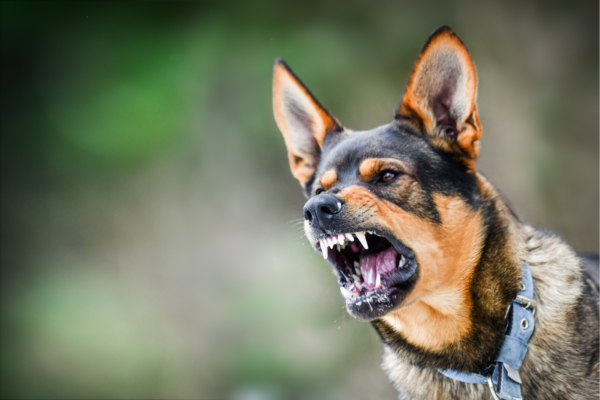
Managing Aggressive Dog Behavior: Tips for Peaceful Living
Living with an aggressive dog may seem challenging, but it can be peaceful and manageable with the right approach. One key aspect is to remain…
June 30, 2023
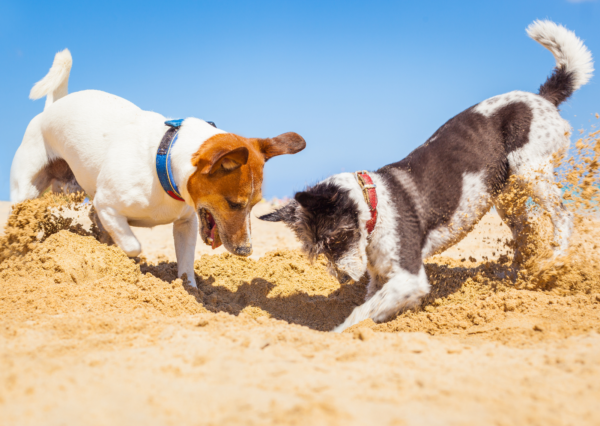
Unlocking the Secret to Successful Puppy Socialization: Quality over Quantity
Today, although the topic is very important, I will keep it brief. Socialization is a topic that could fill books or scientific papers. However, today…

